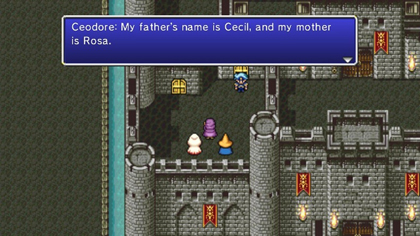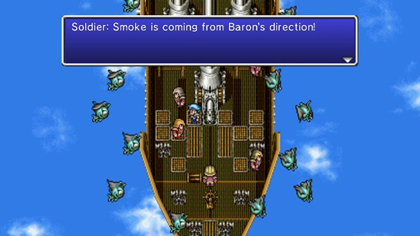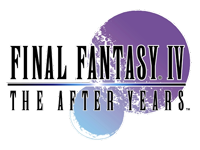In 1991, a humble 16-bit video game changed the way we look at interactive storytelling. That game was Final Fantasy IV (Final Fantasy II on the Super Nintendo Entertainment System). Before Final Fantasy IV‘s arrival, video game narratives were rarely more complex than Plumber collects mushrooms, kills turtle, saves princess; or Boy with sword collects triangles, kills pig wizard, saves princess. Generally you had a world, a silent protagonist, and a goal, and once the last monster was slain, the damsel-no-longer-in-distress gave our hero a smooch and the credits rolled. Final Fantasy IV gave us twelve playable characters working cooperatively, each with unique skills and vivid personalities, each with his or her own (sometimes conflicting) goals and motivations. The Dark Knight Cecil, our protagonist, commits genocide in the first hour of the game. Thus begins a tale of betrayal, love, and redemption that spans three worlds. Mainly sword and sorcery, Final Fantasy IV incorporates dwarves, spaceships, ninjas, the Bible, Norse mythology, and steampunk, and not one element feels inorganic or out of place. The game is a sweeping epic in the echelon of Star Wars and Lord of the Rings, with a script richly written and hundreds of pages long.
Now, after eighteen years, a direct sequel has been released as a WiiWare title—Final Fantasy IV: The After Years. A lot has happened since we left our heroes at the end of the first game. Most of them are world leaders living busy but peaceful lives. Our new hero, Prince Ceodore, is about to become a knight in the kingdom of Baron, which is ruled by his parents Cecil and Rosa, protagonists of the original game. Returning from Ceodore’s knighthood test, his airship is waylaid by monsters and crashes. All aboard are killed save Ceodore, who encounters a hooded man determined to see the prince safely back to Baron. On their journey, they encounter familiar faces, old dungeons, and new adventures.

The updates are slight, and at first glance The After Years looks exactly the original SNES title. But there are differences—though many of the maps are the same, the characters have gotten a bit of an upgrade, putting the imagery on par with Final Fantasy VI. There are a few new innovations to the battle system, including a “Bands System” that allows characters to make combined attacks with their teammates, and an “Age of the Moon” option, which adds bonuses and penalties to certain abilities depending on whether the moon is new, waning, waxing, or full. It sounds silly, but it adds a degree of complexity to an otherwise simple battle system that encourages the use of characters and abilities that most players would otherwise neglect.
If you’re more accustomed to the streamlined control of more recent console RPGs, The After Years may feel a bit clunky. There are also some balance issues. At times you feel like battles are impossible to lose, and other times you’ll be forced to spend a good chunk of time leveling up because your characters are grossly underpowered. One upside to this is that the menus load quickly, so when the same giant bird kills you fifteen times in a row, it will only feel like he has killed you eleven times.

Despite these speed bumps, there is no denying that this is an authentic Final Fantasy game. Produced by scenario writer of the original Final Fantasy IV, Takashi Tokita, The After Years presents many of the tropes so beloved by fans of the series—an anti-hero is redeemed, a boy comes of age, a close friend dies, an extraterrestrial calamity threatens the survival of the planet. Yes, The After Years feels like Final Fantasy, which is an important quality some of Square-Enix’s recent spin-offs (Dissidia, Crisis Core, or even FFXII) have lacked.
What really makes The After Years unique is how you acquire it. It is available only for download on the Wii. For 800 Wii points, you receive the first three chapters of the game where we follow Ceodore with a few cutaways to Cecil and Rosa, Kain, and other heroes from the original. After the first three chapters, other chapters are available for download for 300 points each. Currently, only one additional chapter is available—Rydia’s Tale: “Eidolons Shackled”—with a few more coming out in July, and others in August. The final chapter, where you can import save data from the previous chapters to retain power levels, items, and weapons, will reunite the cast and thrust them into the climax of the game, for an additional 800 points. Some fans are grumbling about this development, feeling cheated. But these first four chapters gave me about ten hours of gameplay without attempting the super hard optional dungeons at the end of each chapter, so working out the math on that, the full game ends up costing the same as a mid-list new release for the DS or Wii, and you get the same amount of content. Seems fair from where I’m standing.
If you read the blogs, some of these complaints will sound familiar. Similar arguments are going on with regards to downloadable movies and books. In Japan, chapter one of The After Years was available free for download, and this idea of breaking up an RPG into chapters, like a comic book or TV show, is innovative. The concept of expansion packs is not new to games. First-person shooters, real time strategies, flight sims, and RPGs all have them, but Final Fantasy is particularly well-suited to this style of release. The series has always been more like an interactive video novel than a free roam tabletop RPG. Only a few chapters in, I’m already reeling with speculation of what will happen next.
The best part is, it’s your call how to play. Buy just Ceodore’s chapter, or buy them all, or play just your favorite supporting character’s chapter, but skip Edward’s, because he’s just a spoony bard.
My score: 8/10










